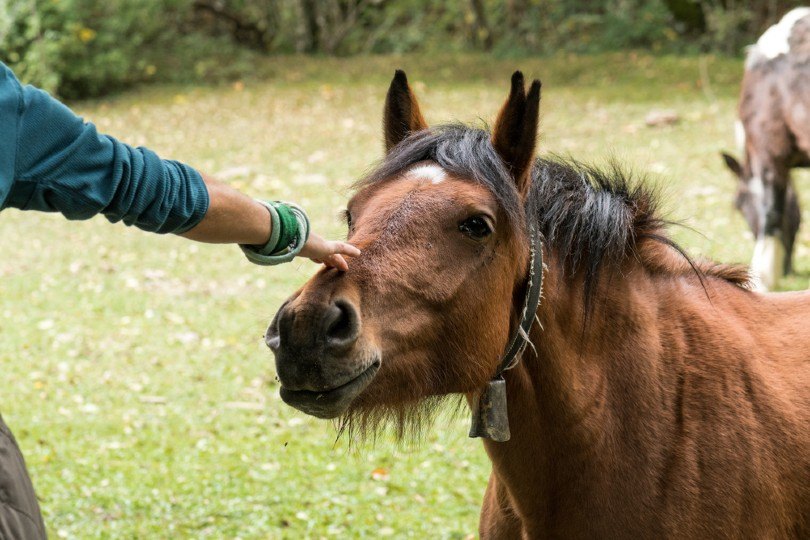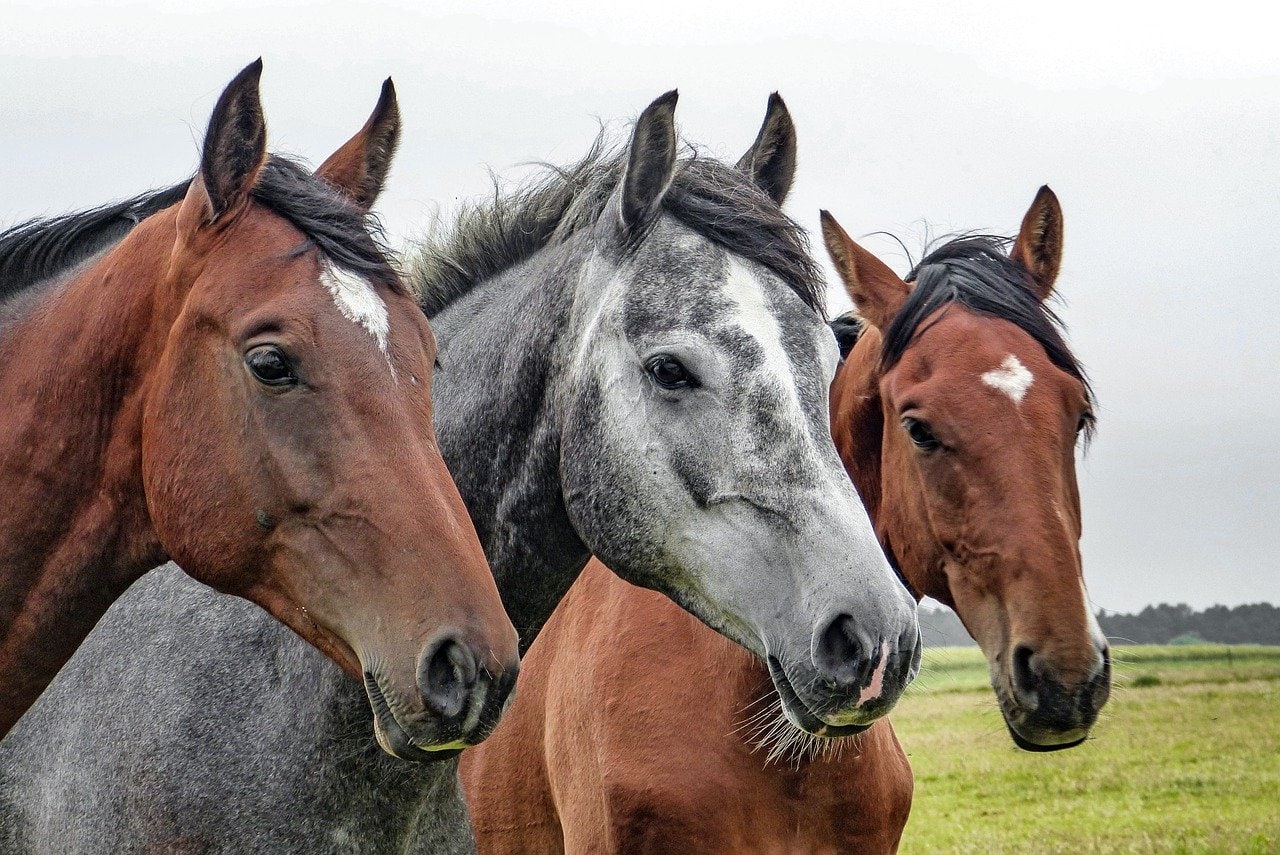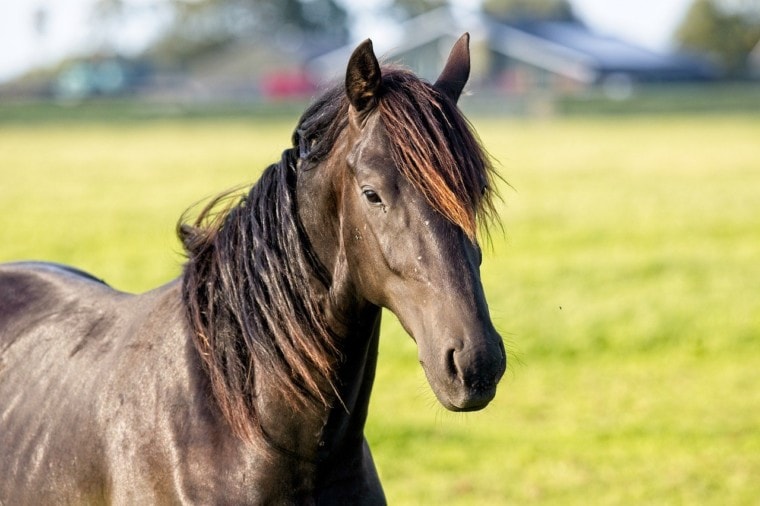
Click to Skip Ahead
Friesian horses are some of the most beautiful and iconic horses in the world. They have a very large stature, a beautiful black coat, and beautiful flowing manes and tails. These horses are almost always the type of horses that little girls dream about. Here is everything you need to know about the iconic Friesian horse.
| Care Level: | Heavy |
| Temperature: | Moderate–Cold |
| Temperament: | Energetic, intelligent, eager to please |
| Colors: | Black |
| Lifespan: | 25–30 years |
| Weight: | 1,400 pounds (stallions), 1,200–1,300 pounds (mares) |
| Height: | 15–16 hands (stallions), 14–15 hands (mares) |
Friesians are purebred horses with a long and winding history. Friesians have been around for centuries, but they almost went extinct due to inbreeding and crossbreeding. They have reemerged on the scene in the modern horse world in a big way. Today, Friesian horses are incredible show horses and competitors. However, they are large and can be hard to handle for inexperienced horse owners. The largest Friesians can weigh as much as 1,400 pounds, making them one of the largest non-draft horses available.
Friesian Horse Characteristics
What Are These Horses Used For?
Friesian horses are by far and away primarily used as leisure horses. They are staples in competitive horseback riding in events such as dressage and driving. Many Friesians are bred purely for competition and show purposes.
Friesians have another primary use that won’t affect most people. They are prominent performance horses but not in a competitive sense. Friesian horses are often found performing in movies, television shows, and traveling shows like circuses. This is because the large size and deep black color make for a striking appearance both in person and on the screen. Many Friesian horses are bred and trained for the entertainment industry, where they have made various appearances throughout the years.
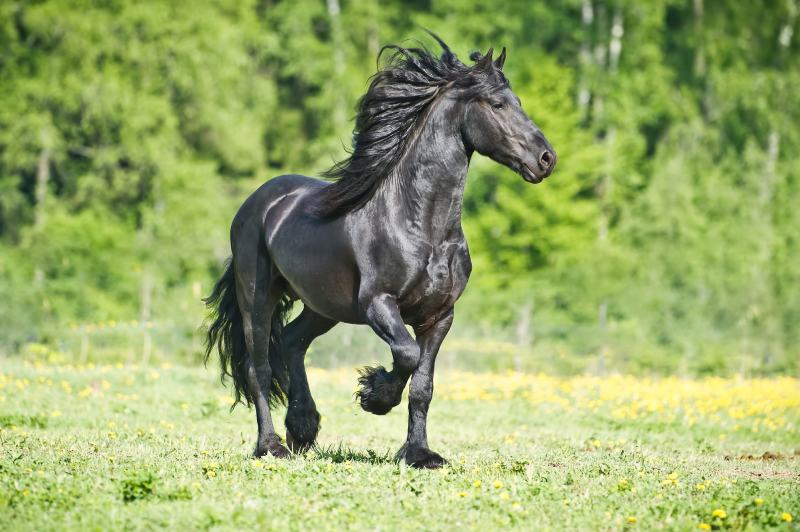
Where Did These Horses Originate From?
The Friesian horse originates from the province of Friesland in The Netherlands. This province is located in the northeast section of the country along the coastline. Friesland was also once known as Frisia, which is where the name Friesian comes from.
The Netherlands has a robust history of equestrianism. Friesian horses have been in existence for thousands of years in one form or another. However, breeding purebred Friesians has not been a goal except for the past century or so. Before then, natural Friesian horses interbred and were crossbred with other native European horses.
There is evidence to suggest that the first Friesian horses were brought to North America as early as the 1600s, but no strong bloodline persisted, and the breed intermingled with native horses and other European horses and largely vanished in its modern recognizable form.
Temperament & Intelligence of the Friesian Horse
Friesian horses are known for being highly trainable. They are able to be put into a variety of different roles and situations and keep their heads. That is a great trait in a horse. Friesians are considered to be intelligent, steady, and calm. They can be a bit spooky or flighty, but they are rarely unpredictable. That makes these horses very versatile and flexible which makes them desirable for certain types of owners and breeders.
Appearance & Varieties
The only official color for a pure Friesian horse is black. Friesians are almost all black from head to toe. The only other marking they typically have is a small white mark on or near the forehead. In the past, due to crossbreeding, there were other varieties and colors. including a red variety, but these have all but disappeared.
There are two varieties of Friesian horse that represent two overarching conformations. The first is a Baroque Friesian. These are large and powerful varieties that often trace their lineage back to the old plowing and warhorse days. There is also a finer, more slender Friesian sport horse. The sport horse variety is often used in competition for things like dressage.

Things to Know When Owning a Friesian Horse:
Habitat & Stable Requirements 🌾
Friesian horses are originally from Northern Europe, so they prefer a cool European climate. However, they can live just about anywhere. If you keep a Friesian horse in a stall, you should make sure the stall measures at least 12 feet by 12 feet, but due to the size of some Friesians, you might want to put them in a 16 foot by 16 foot stall or a double 24 foot by 24 foot stall. If you want to keep them on acreage, you should try to provide 2 acres per Friesian for the best results.
Food & Diet Requirements 🥕
Friesians do best on a diet of local hay and grain. They will need at least a scoop of grain per day and two flakes of hay. If you have the proper amount of land, Friesians can graze on grass, but their size makes it so that you will likely need at least 2 acres of good grass to let a Friesian eat off the land alone. Friesians also will want a salt block if they are kept outside, especially in warm conditions.
Exercise 🐎
Friesians will need exercise if they are kept in a barn or stall. If you are working in an arena, you can lunge them to get their energy out. If you are training your horse for a show, that will often be enough exercise to sate them. Friesians need much less exercise if they are allowed to roam on pastureland.
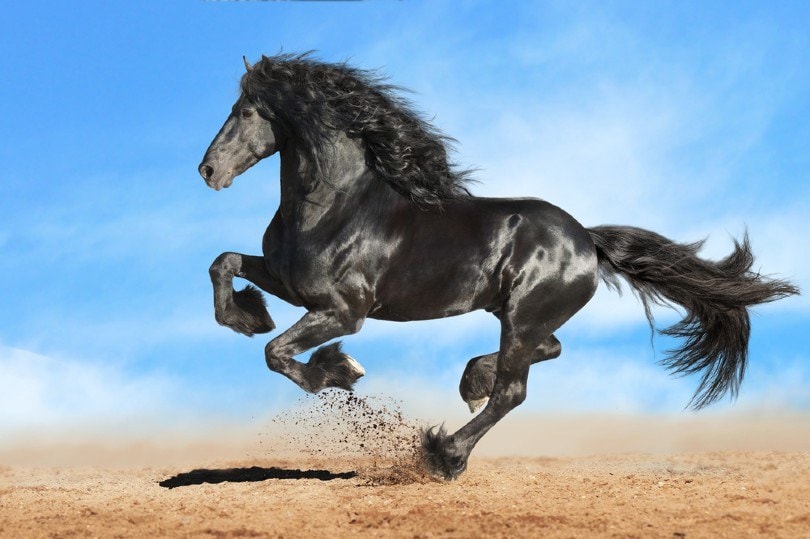
Training🐴
Friesians are capable of undergoing intensive training. Friesians can be trained in multiple vocations, including dressage, driving, and acting. Considering that Friesians are able to be a competitive driving horse or a centerpiece at a Medieval Faire shows their versatility. However, their large size and energy levels can sometimes make them hard to handle.
Grooming 🧽
Friesian horses require serious amounts of grooming. The modern breed standard bars any trimming of the mane or tail. That leaves both long and thick, which requires a lot of brushing, detangling, and bathing to keep them looking their best. If you do not groom your Friesian horse, they will quickly become a disheveled mess.
Lifespan & Health Conditions 🏥
Due to their purebred lineage, Friesians can be prone to a slew of genetic conditions and abnormalities. It takes a prudent and knowledgeable breeder to screen and prevent these types of problems. Some of the worst genetic conditions include dwarfism, hydrocephalus, and bleeding issues.
Minor health issues include skin sensitivity that can flare up in certain situations. Friesian horses with no serious genetic issues can easily live to be near 30 years old. Friesian horses that end up suffering from a major health issue could live for far fewer years (15–20), depending on the severity of the condition.
Male vs Female
Male Friesians can be incredibly large. The largest can measure 16 hands and 1,400 pounds. That is similar to a small draft horse. Females are smaller. They stand shorter, have a leaner build, and weigh slightly less than the males. Otherwise, color and confirmation are the same between the two sexes of the Friesian horse.
3 Little-Known Facts About Friesian Horse
1. Friesian Horses Are Often Used in Film and TV
Due to their size, trainability, and striking color, Friesians make excellent television horses. They are very large, which makes them look imposing on the big screen. Famous Friesians you might have seen on the big screen include Black Beauty and Othello from the film Ladyhawke.
2. Purebred Friesians Were Rare for a Long Time
The idea of breeding purebred horses for specific characteristics or appearances was not always a thing. For a long time, robust Friesian horses were bred into other horses to create hardy crossbreeds. This pattern of crossbreeding and intermingling breeding stock diluted the original Friesian breed until it was nearly extinct. Friesian DNA has always been present in European horses, but the classic phenotype has not always been.
3. Dutch Settlers Brought Friesian Horses to America Centuries Ago
The first Friesians likely made it to the New World as early as 1600 CE. The Dutch were actually some of the earliest settlers to make it to the New World (they were the ones that founded New Amsterdam which would later become Manhattan.) These early settlers brought their trusty steeds with them when they emigrated.
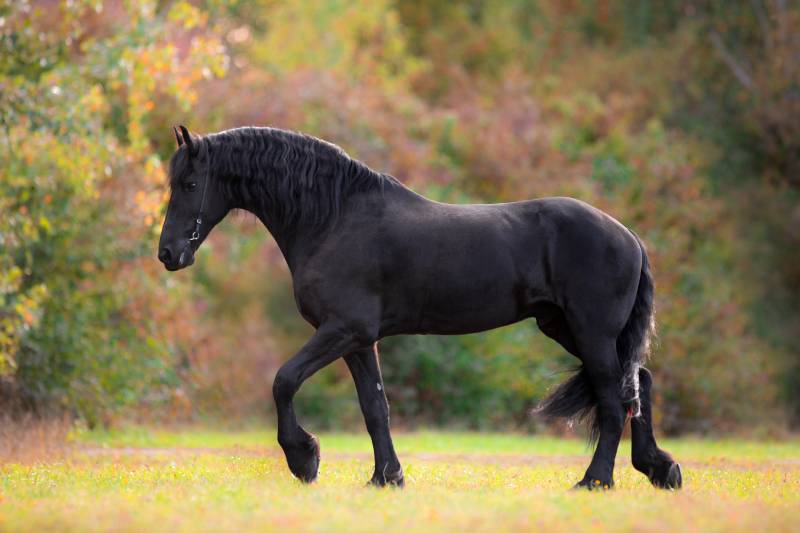
Final Thoughts
Friesian horses are large and beautiful examples of peak horse anatomy. These horses are stunning and make excellent show horses. Many people prefer Friesian horses for showmanship. However, these horses require a lot of food, a lot of space, and a lot of grooming to upkeep. But for the right person, it could all be worth it. A true pure black Friesian is a sight to behold.
Featured Image Credit: AlkeMade, Pixabay




